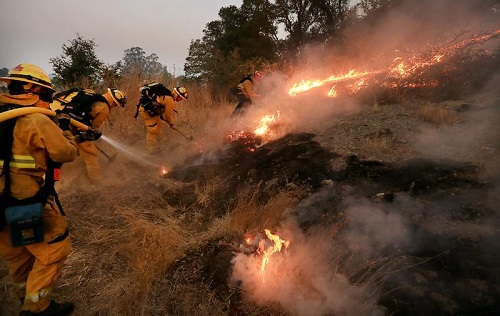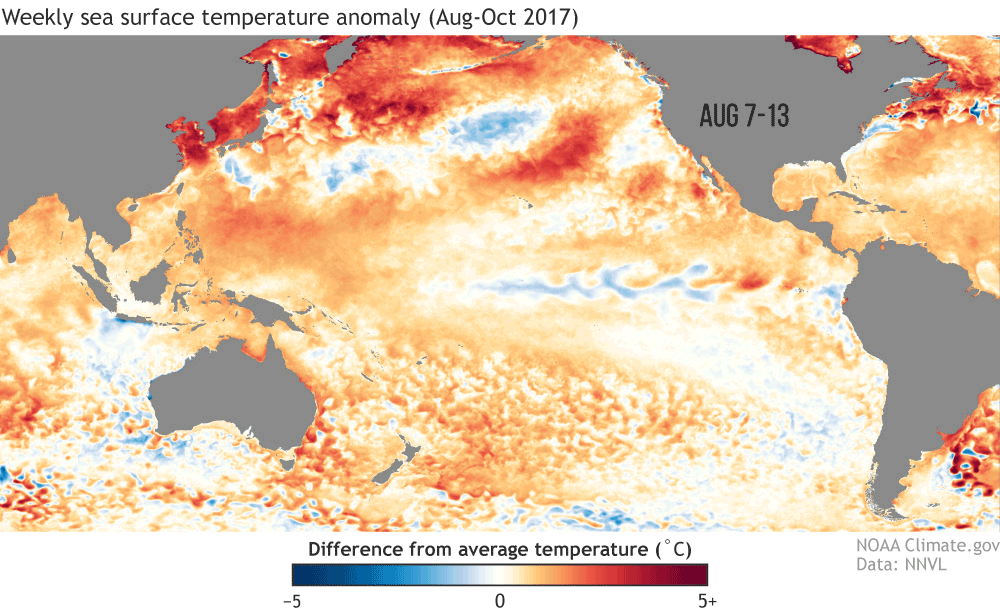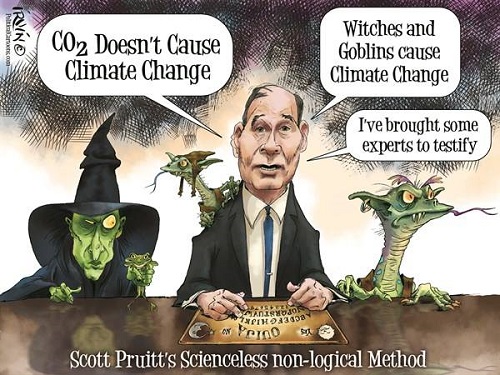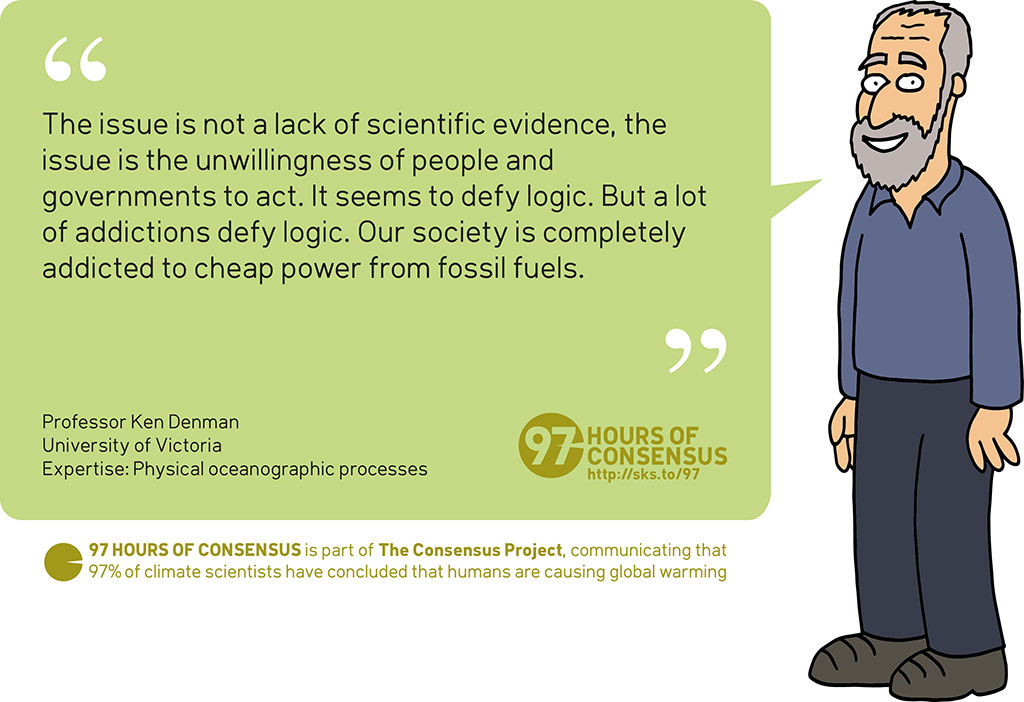2017 SkS Weekly Climate Change & Global Warming Digest #41
Posted on 15 October 2017 by John Hartz
Story of the Week... El Niño/La Niña Update... Toon of the Week... Graphic of the Week... SkS Spotlights... Coming Soon on SkS... Poster of the Week... SkS Week in Review... 97 Hours of Consensus...
Story of the Week...
Firefight in Sonoma County reaches second week as flames force thousands to evacuate

Firefighters from Compton put a scratch and wet line around a fire on Lovall Valley Road in Somona, Saturday, Oct 14, 2017. (Kent Porter/The Press Democrat) 2017
An army of firefighters with a larger aerial arsenal at their disposal held their ground and made some gains Saturday on devastating wildfires ravaging Wine Country, but evacuation orders that forced thousands from their homes before dawn and a rising death toll were clear reminders of the peril that still grips the region.
Northeast winds that arrived early Saturday whipped up a new fire in the hills outside eastern Santa Rosa, and spread an existing blaze outside Sonoma, prompting another round of nighttime evacuation orders.
Thousands of Santa Rosa residents were forced to leave — some for the second time since last Sunday — while others faced their first mandatory orders in Sonoma.
Firefight in Sonoma County reaches second week as flames force thousands to evacuate by Kevin McCallum & Randi Rossmann, The Press Democrat, Oct 15, 2017
El Niño/La Niña Update
The task of a climate forecaster is to see the forest, and not get hung up on the individual trees. Especially that extra tall one over there, with the gnarl that looks like a face, and the low branches that would be so easy to climb, and… uh, right. My point is that we try to look beyond shorter-term weather to see longer-term monthly and seasonal patterns. After all, a particular winter can have several colder-than-average days and still be warmer than average overall.
Which brings me to the current situation in the tropical Pacific! The October ENSO forecast says La Niña conditions are favored during the fall and winter 2017-18, but at press time the ocean-atmosphere system didn’t quite meet the criteria for a La Niña Advisory. Specifically, while the atmosphere is generally consistent with La Niña, the sea surface temperature in the Niño3.4 region has been volatile, recently edging up close to average following several weeks near or below the La Niña threshold (0.5°C colder than average).

Animation showing sea surface temperature departure from the 1981-2010 average from early August through early October 2017. Graphic by climate.gov; data from NOAA’s Environmental Visualization Lab.
Is the overall pattern truly La Niña, with some short-term fluctuations temporarily obscuring the pattern? Or has the atmosphere-ocean system really not settled down into a consistent pattern at all? The difference between these two scenarios is subtle, and the ENSO forecast team is maintaining the La Niña Watch as we wait for a clearer picture. The forecast is for that picture to become clearer soon, with La Niña conditions 55-65% likely during this fall and winter.
October 2017 ENSO update: Still watching for La Niña by Emily Becker, NOAA's Climate.gov. Oct 12, 2017
Toon of the Week...

Graphic of the Week...
Today, U.S. Environmental Protection Agency Administrator Scott Pruitt issued a Notice of Proposed Rulemaking to repeal the Clean Power Plan. In response, Janet Redman, U.S. Policy Director of Oil Change International issued the following statement:
“Pruitt’s move to repeal the Clean Power Plan shouldn’t come as any surprise. He’s repeatedly partnered with fossil fuel companies to sue the EPA for regulating the industry’s air, water, and climate pollution. This kind of cronyism is exactly what happens when government agencies are captured by the corporations they’re supposed to oversee.
“According to Pruitt, this is just another way to even the playing field for coal, oil, and gas – but he knows as well as anyone that fossil fuels already get massive government giveaways. In fact, permanent tax breaks for the fossil fuel industry are seven times higher than those for renewable energy.
“The fight to curb the worst abuses of the fossil fuel energy industry won’t stop here. Federal legislation, the courts, and millions of voters have made it clear that the federal government is obligated to protect American workers and families from the deadly impacts of dirty energy, not hand polluters taxpayer dollars.”

Oil Change International Statement On Clean Power Plan Repeal, Oct 10, 2017
SkS Spotlights...

The Climate Literacy and Energy Awareness Network (CLEAN) Portal was launched in 2010 as a National Science Digital Library (NSDL) Pathways project. It is led by the science education expertise of TERC, the Cooperative Institute for Research in Environmental Science (CIRES) at the University of Colorado Boulder, and the Science Education Resource Center (SERC) at Carleton College. As of 2012, CLEAN has been syndicated to NOAA's climate.gov portal.
CLEAN's primary effort is to steward the collection of climate and energy science educational resources and to support a community of professionals committed to improving climate and energy literacy.
The three key components of the CLEAN project are:
1. The CLEAN Collection of Climate and Energy Science resources- high-quality, digital resources—including learning activities, visualizations, videos, and short demonstrations/experiments—geared toward educators of students in secondary through undergraduate levels.
2. Guidance in Teaching Climate and Energy Science – pages designed to help educators understand and be equipped to teach the big ideas in climate and energy science.
3. The CLEAN Network – a community of professionals committed to improving climate and energy literacy.
Coming Soon on SkS...
- The war on coal is over. Coal lost (Dana)
- The F13 files, part 1 - the copy/paste job (Ari)
- Guest Post (John Abraham)
- Americans want a $15 per month carbon tax; but how to get one? (Dana)
- New research this week (Ari)
- 2017 SkS Weekly Climate Change & Global Warming News Roundup #42 (John Hartz)
- 2017 SkS Weekly Climate Change & Global Waming Digest #42 (John Hartz)
Poster of the Week...

SkS Week in Review...
- 2017 SkS Weekly Climate Change & Global Warming News Roundup #41 by John Hartz
- New research, October 2-8, 2017 by Ari Jokimäki
- SkS Analogy 10 - Bathtubs and Budgets by Evan & jg
- Despite Trump, American companies are still investing in renewable energy by John Abraham (Climate Consensus - the 97%, Guardian)
- Analysis: How well have climate models projected global warming? by Zeke Hausfather (Carbon Brief)
- Trump’s plan to bail out failing fossil fuels with taxpayer subsidies is perverse by Dana Nuccitelli (Climate Consensus - the 97%, Guardian)
- 2017 SkS Weekly Climate Change & Global Warming Digest #40 by John Hartz
97 Hours of Consensus...

Quote derived with author's permission from:
"The issue is not a lack of scientific evidence, the issue is the unwillingness of people and governments to act. It seems to defy logic. But a lot of addictions defy logic. Our society is completely addicted to cheap power."































 Arguments
Arguments






























Regarding your article on these irrational, absurd fossil fuel subsidies. This article pointed out politicians receive considerable campaign donations from fossil fuel companies and a lot of lobbying pressure in general, and the potential for this to affect their decision making. It seems unfortunate to me, and equally unfortunate that there are no limits in law on campaign donations in America, and no consideration of other funding methods. Its very unfortunate, because powerful corporate lobbying groups can entirely dominate.
The very fine American Constitution has limits on government, to prevent abuse of power by government. But it doesn't have any limits on activities of private sector and other lobby groups, and funding provided by private sector lobby groups who can equally abuse their power. Is this not a massive inconsistency?
What I really got a chuckle over was a previous article which said that coal, that great supplier of base load, shuts down when it really gets cold. Who would have thought.
The U.S. Global Change Research Program Climate Science Special Report has been released. Link is to the Executive Summary. This is similar to the IPCC report but not as long and it focuses on the USA. I find this report easier to read than the IPCC report.
For Sea Level Rise:
Note the area of 5+ feet of rise (for the intermediate scenario) in the Gulf Coast.
A separate report on impacts will be released next year.
[DB] Fixed image width.